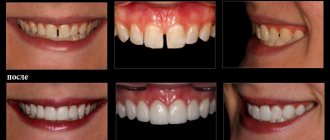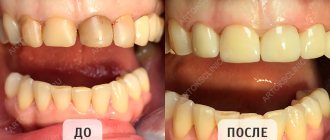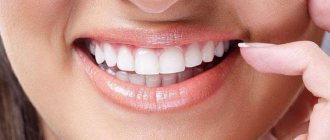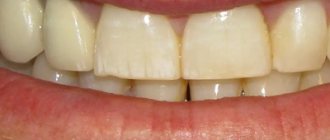Veneers
Ceramic “scales” that are attached to the surface of the teeth after preliminary grinding.
Tabs
Microprostheses made of ceramics.
When working with veneers, artistic restoration of teeth is performed in 3 stages:
- Examination, professional oral hygiene, planning, taking impressions. Modeling future restorations in wax or plastic. At this stage, the doctor and the patient select and adjust the shape and color. Taking high-precision impressions for permanent structures, the impressions are sent to a dental laboratory. Also, at each visit, before fixing permanent restorations, the tooth is processed and closed with a temporary filling.
- Removing the temporary filling. Treatment of the tooth surface. Isolation of dental units from moisture. Drying the surface and fixing the overlay, veneer. Lighting and polishing.
Our clinic uses advanced materials and indirect restoration techniques, which do not always require enamel removal. We use this approach when we detect a diastema, trema, or spaces between teeth in a patient.
The production time for veneers is 7 days.
Service life - 10−15 years.
Aesthetic dental restoration with veneers - advantages and disadvantages
Advantages
- Predictability of the result. Thanks to close cooperation between the doctor, dental technician and patient
- Naturalness. Inlays and onlays are no different from other teeth
- Does not require special care
- Ceramic products prevent the formation of plaque (bacteria cannot cling to a smooth surface)
- They are not afraid of temperature changes, do not darken or wear off over time
Flaws
- Incomplete restoration of chewing functions. We do not recommend eating solid foods
- Relatively high cost (compared to direct restoration)
- Enamel grinding in most cases
Indications and methods for artistic dental restoration
Artistic restoration of teeth
This is a method in which the natural structure of the tooth is restored by copying dental tissues with various materials. Restoration can be carried out to change the position of teeth, to change their color and to eliminate existing defects.
Video example of restoration of anterior teeth (incisors) with composite material (eng)
Video of restoration of the upper canine with composite material (eng)
Dental restoration is a treatment whose indications are the presence of caries, any non-carious lesion of the tooth (fluorosis, enamel erosion, abrasion of the surface of the teeth, etc.), chips and cracks, gaps between teeth, enamel pigmentation, as well as incorrect positioning of teeth in dentition. At the moment, there are direct and indirect methods of dental restoration. Which method will be used depends on the problem that needs to be fixed and your wishes.
Direct dental restoration
It is performed directly in the dentist’s chair using special restoration materials. The convenience of this method lies in the fact that in one visit to the doctor you can solve your problem and enjoy a beautiful smile. However, there are cases when indirect dental restoration may be necessary; the prices for dental services in this case will be significantly higher than for direct restoration. This restoration method involves the production of thin porcelain or composite plates - veneers.
Indirect dental restoration
Now it is accepted as very high quality, since it requires making the most accurate shape of the material for your tooth in the laboratory. Due to this, such similarity with natural dental tissues is achieved.
Dental restoration techniques are used differently depending on the chosen restoration method. They differ in that with the indirect method, this technique takes place in several stages. With the indirect method, two visits to the doctor are required, taking an impression, installing a temporary filling, fitting, and only then installing the restoration material.
Our specialists will select the most suitable restoration method for your specific case and answer all questions that may arise. Teeth restoration before and after photos will show you what effect our doctors achieve.
What materials are used for dental restoration?
Dental restoration is the restoration of a chipped, broken or partially destroyed tooth by caries or in some other way. The materials used for dental restoration depend on which method was chosen. For direct restoration, the dentist uses composite materials (photopolymers); indirect restoration is longer and more expensive, because this method requires time to make a veneer from ceramic mass.
Dental restoration with composite materials has many adherents around the world. The development of aesthetic dentistry allows the use of the latest restoration materials, which helps patients not be embarrassed about their smile after just a couple of visits to the doctor. Photopolymers, which have found their application in the restoration process, are very convenient to work with, because they very easily take the desired shape. Composite dental restoration allows you to change the color of a tooth, restore and change its shape, and close the gaps between teeth.
Prices for dental restoration using photopolymer composite will depend mainly on the degree of damage to the tooth, the chosen treatment method and the composite material used. Dental restoration using filling material is in many ways inferior to restoration using veneers. Over time, this material may darken, lose its shine, and if the tooth is severely damaged, such a restoration can be destroyed under the influence of external factors.
When is direct restoration needed and when is indirect restoration needed?
Direct restoration is indicated for minor damage to the hard tissues of the tooth. Such as:
- caries;
- damage to the proximal surface;
- the presence of cracks and chips within the enamel layer.
Indirect restoration is indicated for:
- restoration of 50% or more of damaged tooth tissue;
- malocclusion due to pathological abrasion;
- orthopedic rehabilitation after orthodontic correction;
- increased patient requirements for aesthetics;
- if desired, obtain a long-term predictable result.
Materials:
For direct restoration, doctors at a modern clinic use a light-curing composite from the group of nanohybrids.
For indirect, all-ceramic blocks and all-zirconium discs and blocks are used.
It is very important that the center, the Moscow clinic where the patient goes, works with proven manufacturers of high-quality dental material.
Requirements for materials for dental restoration
Both aesthetic and artistic restoration of teeth cannot be performed with any filling material. Despite the fact that there are a lot of them and they are all high-tech.
Important properties of filling material:
- best adaptation to dental tissues;
- long working hours. The dentist must have enough time for artistic modeling and restoration of teeth;
- high strength and durability;
- low percentage of shrinkage, absence of it. Do not shrink much during photopolymerization;
- have fluorescent properties. Match as closely as possible the degree of fluorescence of the tissues of your own teeth. Otherwise, in neon light, instead of beautiful restorations and fillings, we will get black spots.
Sequence of the dental restoration process
There is a certain sequence in which the restoration procedure is carried out. This methodology must not be violated, otherwise you will not get the desired result. So, the stages of dental restoration:
- Preparation for the restoration procedure. The tooth surface is mechanically cleaned, anesthesia is applied if necessary, and the tooth is isolated from saliva using a rubber dam.
- Tooth preparation. Removing pigmented enamel, softened dentin and cleaning teeth from caries.
- Gasket application. It is necessary to protect the pulp from possible exposure to the composite.
- Etching dentin and enamel. It is necessary for the sterility of the surface of the cavity and promotes better adhesion of the hard tissues of the tooth to the composite.
- Applying primer to the surfaces of enamel and dentin. Makes dentin airtight, thereby limiting it from any external influences due to clogging of dentinal tubules.
- Application of composite and its plastic modeling.
- Composite polymerization. Hardening of the composite material.
- Final processing of the restoration. The surface is modeled and formed after restoration.
- Carrying out control tests and correction of restoration work.
- Surface polishing.
- Final polymerization.
Dental restoration using photopolymer composites: stages of the process
Before moving on to the restoration of damaged teeth or units with poor aesthetics, the doctor will definitely conduct a thorough examination of the oral cavity for the presence of dental diseases. Next, the restoration process will be divided into the following stages:
Professional sanitation of the oral cavity
At this stage, the teeth are cleaned of all types of plaque - hard and soft, tartar. Sanitation of the oral cavity is necessary to accurately determine the shade of natural tooth enamel. Based on a certain shade, the dentist will choose the tone of the composite material, which will allow you to obtain the most aesthetic result of dental restoration.
Anesthesia of the restoration area
It is carried out using local anesthetics. Anesthesia is not always necessary, but only in cases where the tooth is severely damaged by caries. The anesthetic is selected individually and allows for tooth restoration without the slightest discomfort for the patient.
Removal of tissues damaged by caries and old fillings
Before carrying out the restoration, the doctor must properly treat the tooth: remove all tissue destroyed by pathological processes, old and unusable fillings.
Moisture insulation is the most important stage in tooth restoration
In order for a tooth restoration to be not only aesthetically pleasing, but also durable, the area where the manipulation is performed must be properly protected not only from saliva, but even from moisture contained in the patient’s breath.
Cotton swabs were previously used for this purpose, but they did not provide reliable moisture protection. In modern clinics, a special latex lining, a rubber dam, is used to perform moisture insulation. Externally, this pad looks like a handkerchief with slits. The rubber dam is tightly stretched over the teeth and prevents moisture in one form or another from entering the area of restoration work. It is advisable that in the process of dental restoration, a specialist uses a rubber dam, since insufficient protection of the restored tooth from moisture is fraught with a number of negative consequences:
- The edges of the photopolymer filling will not adhere to the natural tissues of the tooth with sufficient density, and this is fraught with the formation of a noticeable dark stripe at the border of their contact or the development of caries in this area;
- An installed filling can quickly fall out, since moisture reduces the degree of adhesion (adhesion) of the photopolymer and dentin.
Installation of a pin in the dental canal
A pin is not always installed during dental restoration, but only when a dental unit is destroyed by more than fifty percent and is depulped. Installing a pin allows you to make the restoration as strong as possible and avoid the filling falling out.
Tooth restoration
At the final stage of the treatment process, the doctor performs the actual restoration, that is, restores the shape and aesthetics of the tooth with photopolymer filling material. The restoration is carried out layer by layer and photopolymers of different shades and transparency levels can be used to create layers - this is necessary so that the result of the restoration work has high aesthetics. The restoration is completed by processing the filling with burs, grinding it and sealing it.
Alternative restoration
Restoration of the tooth crown
Can be produced in various ways. Our clinic offers them all. This can be traditional dental filling, covering the tooth surface with veneers, restoring the anatomical shape of the tooth using a crown, or any existing method of prosthetics (implants, inlays, etc.). The main task of the dentist is to choose and offer the patient the most optimal method of tooth restoration.
Dental restoration with veneers
This method will be acceptable in the following cases:
- treatment of chipped teeth;
- getting rid of a small gap between the front teeth;
- changes in enamel color that cannot be bleached in any other way;
- changes in the shape of the tooth crown;
- changes in moderate curvature of teeth.
Dental restoration with inlays
It is used for minor tooth damage, when restoration of 1-2 sides is necessary. There are restorative (restore the shape and color of the tooth) and stump (a crown is then placed on top of them) inlays. Inlays can be made of metal, ceramics, metal-ceramics, as well as composite and all-ceramic.
If your tooth is more than half destroyed, and even more so if the nerve in it has also been removed, then it is recommended to install a crown. They are ceramic and metal-ceramic. Service life, aesthetics and reliability are superior to conventional restoration methods.
Disadvantages of restorations –
- Restorations darken and lose their shine over time - fillings and restorations made from light-polymer filling materials tend to gradually darken. In addition, they lose the shine characteristic of healthy tooth enamel. If the loss of aesthetics on chewing teeth is not so terrible, then on the front teeth it is very unpleasant. Not very good restorations will have to be replaced every few years, but high-quality restorations should require periodic care (you need to visit the dentist once a year to polish them) - then their aesthetics will last longer.
- Risk of breakage of restorations - if your tooth is destroyed by more than 1/2, and especially if it is also depulped (nerve removed), and you still want to chew meat, then there is a risk of breakage of the restoration.
Depulped teeth are much more fragile than living ones. Particularly often, restored teeth break when the tooth is restored completely from the root. If the chewing load suddenly exceeds the strength limit of the restored structure, the restored part of the tooth breaks off. Sometimes this even causes a fracture of the tooth root (with the need for its subsequent complete removal). What is the best way to restore a tooth if it is destroyed by more than 1/2 - this is where indirect aesthetic restorations will help us, because ceramic crowns, veneers, etc.
Contraindications for dental restoration procedures
- The patient has an incorrect bite.
- Absence of a certain number of chewing teeth.
- The presence of a disease - bruxism.
- Monolithic destruction of the inner enamel of the tooth.
- Unnatural tooth wear.
- Passion for dangerous sports (for example, boxing).
However, some indications can be treated, so the possibility of restoration should not be abandoned forever. You can cope with bruxism or correct a malocclusion and then contact us for dental restoration.
Prices for aesthetic restoration:
| Consultation with a dentist | Comprehensive examination, diagnosis, treatment plan | 1000 rub. 500 |
| Taking impressions | Complex | 2500 rubles |
| Ceramic veneer E-Max | One surface | 25,000 rubles |
| Splinting using fiberglass thread | up to 4 units | 8000 rubles |
| Artistic restoration | anterior or chewing tooth | 5000 rubles |
Why is tooth stump restoration necessary?
Tooth stump restoration is used in dentistry to restore a badly damaged tooth to a degree that allows the tooth to be prepared for installation of an artificial crown. Recently, dentists have been actively using the direct method of restoring the tooth stump (pinless method), which uses special composite materials. Very often, when a tooth is severely damaged, only the root remains and for greater support, it is necessary to install a pin (pin method). The mouth of the canal is widened, treated, filled, and only after that can a pin be installed.
There is also another way to restore a tooth stump - a cast stump inlay. This is a custom made metal post that restores the portion of the tooth above the gum. This is a monolithic alloy that has no seams or joints, which gives it greater strength and resistance to heavy loads.
Artistic restoration of anterior teeth
Dental restoration in Moscow today is available to everyone, and it is especially important for that part of the teeth that we show to others. Artistic restoration of the front teeth requires good skills from the dentist not only from a medical, but also from an aesthetic point of view. This type of restoration is the most popular because people want to smile without embarrassment. Restoration of the anterior group of teeth by specialists at our clinic today is able to correct any tooth defects from chips and cracks to giving the natural color of tooth enamel.
There are direct and indirect restoration of anterior teeth. Only consultation with a specialist can help you choose one of these methods. In the first case, reflective filling materials are used. This process is based on layer-by-layer application of photopolymer material, which requires the skill and experience of a doctor. This method can be used for minor damage to the tooth, as it is subject to abrasion over time. Restoration of the frontal group of teeth, when choosing an indirect method, is based on the work of the doctor, which consists of observing several rules:
- correct selection of the color of the desired material for the veneer;
- using the correct tooth preparation technique;
- taking impressions of the front teeth;
- installation of temporary and then permanent veneer.
Restoring the front teeth with veneers will be appropriate if, after some dental procedures, it is no longer possible to achieve color by whitening. They can also be used to slightly correct the shape of your teeth. Depending on the manufacturing method and material, veneers are divided into therapeutic ones made of composite material and orthopedic ones made of ceramics. Only a qualified dentist can tell you which type you need. The effect obtained from this method of restoration can be seen in the photo before and after restoring teeth with veneers.
Few people think about the fact that when we talk or laugh, the lower part of the teeth is always visible. Therefore, restoration of the lower teeth is extremely important and simply necessary for a healthy and beautiful smile. Also, a very large load is placed on the lower row of chewing teeth, which contributes to the frequent formation of chips and caries. Therefore, you need to understand that artistic restoration of chewing teeth is important not only from a practical, but also from an aesthetic point of view.
Aesthetic restoration of the front teeth from below and above is necessary, first of all, for people who have problems with their teeth, but want to be self-confident and not be afraid of communicating with other people.
Indications for use
- Chips.
- Destruction.
- Severe carious lesion.
- Darkening, thinning of enamel, sensitivity, spots, irregularities.
- Diastemas.
- Loss of fillings.
- Crooked teeth
- Partial or complete loss of a unit.
- Congenital developmental anomaly.
Artistic restoration of anterior teeth
Artistic restoration of the front units
– the most popular procedure, since the smile line is always visible. The patient needs artistic restoration for various reasons. When the cutting edge of the upper front tooth is chipped, the dentist needs to restore its natural curves.
The wedge-shaped effect occurs in the area of the tooth neck and significantly disrupts aesthetics; teeth react to sour/sweet, hot/cold. If the color of the anterior units changes, an intracanal bleaching procedure is performed. Filling material is often used to correct small defects.
The work of a doctor is comparable to the work of a sculptor. It is necessary to restore the defect with jewelry, taking into account the color, degree of transparency, and shape of the organ. The main criterion is naturalism in natural and artificial lighting. The skill of the doctor in the absence of traces of his intervention.
Artistic restoration of lateral teeth
The lateral units most often require restoration of the chewing surface. Restoration of fissures with their anatomical shape. Paints are often used to create the effect of natural recesses. Composite material of different shades is used to create the effect of multi-layered enamel.
Diagnostics, examination
To carry out restoration, it is necessary to identify the degree of damage and the presence of inflammation in the soft tissues. The dentist identifies the cause of the defect and how to eliminate it. The doctor examines the oral cavity, identifies contraindications, and selects a method to achieve the desired result.
Selecting a recovery method
When choosing a restoration method, the doctor will take into account the degree of tissue preservation, the size of the lesion, the possibility of progression of tissue destruction, the speed of the process, as well as the desired result and the financial side of the issue. Modern dentistry allows you to prolong life and restore the original beauty of teeth for many years. In this case, gentle methods are used.
Price of restorations
Artistic restoration price
front teeth depends on the method of restoration, the selected material, the number of units, the class of the clinic, and the qualifications of the doctor.
| Type of restoration | Price, rubles |
| Lumineers, one piece. | 40000 |
| Direct restoration with composite materials | 1000-4000 |
| Veneers | From 4500 for the cheapest |
| Metal-ceramic crown | From 6000 |
| Porcelain/zirconium oxide crown | From 15000 |
| Filling material | 3500 without pin, 5500 with pin |
Care, service life
After restoration, it is important to handle the restored units and the entire oral cavity with care. Regular brushing of teeth, use of floss, irrigator, do not chew nuts and seeds. Every six months, undergo hygienic cleaning and, if necessary, polishing.
| Type of restoration | Number of years |
| Filling material | 10-15 |
| Composite materials | 10-15 |
| Veneers | To 10 |
| Lumineers | 15-20 |
| Crowns | From 5 porcelain, 10-15 metal, 15-20 zirconium dioxide |
Restoration of the chewing group of teeth
The main goal pursued during the restoration of lateral teeth is the restoration of their functionality, that is, the restoration of chewing function. Restoration of lateral crooked teeth is necessary for several reasons.
Firstly, excessive curvature of the teeth can tear the gums, thereby causing discomfort and pain when eating.
Secondly, an incorrect bite can lead to incorrect redistribution of the load on the teeth.
Third, wide and flat surfaces will cause severe tooth wear and reduce chewing efficiency.
All these factors can negatively affect the general condition of all teeth. Therefore, during restoration, reproduction of the individual characteristics of the tooth, including macrorelief, all tubercles and pits, plays a very important role. You should monitor the health of all teeth without exception, not paying attention only to those that are visible when you smile.
Restoration of the incisal edge
Enamel is the hardest tissue in our body. But over time, it becomes thinner, including due to improper brushing techniques or the use of abrasive pastes. This is fraught with the appearance of microcracks and chips on it. Especially at risk are those who have bad habits: chewing seeds, nuts, or the tip of a ballpoint pen. Restoration of the cutting edge of the tooth helps to correct the shape of the tooth and its cutting edge, and hide enamel defects.
This is not an easy procedure that requires painstakingness and creativity, because the anatomical shape of everyone’s teeth is different. In addition, the tooth has a relief, individual shade and transparency. The specialist’s task is to make sure that the restored tooth does not differ from the rest.
Front Tooth Reconstruction. Source: Futurism YouTube channel
Few people know that the color of the enamel changes from the neck to the cutting edge. It seems that the changes are insignificant, but if this feature is not taken into account, the restored tooth will look like a plastic crown. The same can be said about transparency.
Restoration of baby teeth in children
Today, even a child can have a tooth restored in our clinic. Restoration of a baby tooth is necessary in case of injury or extensive carious destruction. This method allows you to completely restore the anatomy of the crown of a baby tooth, which will allow you to preserve it until it is naturally removed and replaced with a permanent tooth. Do you think saving a baby tooth makes no sense?
You are wrong, because the health and well-being of baby teeth has a direct impact on the condition of permanent teeth. Plus, a baby tooth that falls out unnaturally can cause deformation of the dentition. After all, if the permanent tooth has not pushed it out, but the gums are empty and the neighboring teeth may begin to move. In addition, premature tooth loss can lead to deterioration of diction, changes in bite, increased load on neighboring teeth, which can also fall out prematurely and many other negative consequences. Thus, we come to the conclusion that the need for restoration of temporary teeth should not be ignored by parents. Timely intervention by a dentist in the problem will help avoid complications in the future.
Aesthetics in dentistry
In our society, a beautiful snow-white smile has already become not just a sign of health and well-being, it is good manners. That is why cosmetic dental restoration in Moscow is now so popular. Now it is customary to sparkle with the whiteness of your perfectly straight teeth and even decorate them with precious stones.
Aesthetic dental restoration involves giving the ideal appearance of the tooth, its color, shape and structure. In the hands of a professional dentist, restorative materials transform teeth into works of art. Since modern aesthetic restoration implies the complete elimination of any changes and defects on the surface of the tooth. This is exactly the kind of modern dental restoration on Vernadsky Avenue (Yugo-Zapadnaya metro station) that is available to everyone. Our clinic’s specialists will advise you and tell you what types and how restoration of tooth color, enamel and shape occurs. They will advise you on prices and explain what results you should expect from each specific restoration method.
In order to achieve a beautiful shape and durable dental covering, our dentistry uses high-quality composite materials. These materials come in a huge variety of colors to give the teeth a natural appearance and similarity to the patient's other teeth. Restoring the shape of teeth allows them to return their functionality, as well as make the size of the teeth more suitable to each other from an aesthetic point of view.
Aesthetic restoration of anterior teeth is designed to give a natural shape to the tooth line. It is known that teeth darken with age, and teeth with a removed nerve also have this unpleasant property. The color of enamel is negatively affected by eating foods that have coloring properties, as well as smoking. In modern dentistry, there are many teeth whitening systems. Restoration of tooth enamel can be carried out using any of them or by applying special lumineers and veneers.
You can contact our clinic and get all the information you are interested in about how artistic dental restoration works. Our prices are quite reasonable, and the quality of the services provided makes you come back to us again and again.
Aesthetic dental restoration video shows how the procedure takes place in the clinic.
The best material for teeth is ceramics
Ceramics have been used in dentistry for many years and are very successful. Dental restoration with ceramics is the best way to achieve an invisible and high-quality result. Dental restoration of teeth requires not only the correction of teeth from an aesthetic point of view, but also the elimination of more serious defects. Crowns, veneers, lumineers, bridges, etc. are made from this material.
Lumineers are made from high-strength pressed ceramic. They are resistant to mechanical damage, look very natural and are durable. This is an ideal replacement for regular teeth whitening.
Ceramics also have another very important quality - a wide range of colors. Choosing the right color is not difficult, since the choice is large, you can find all natural shades of teeth.
Now you have access to high-quality ceramic dental restoration at Yugo-Zapadnaya. To do this, you must come to us, here you will be pleased not only with the quality of the services provided and the professionalism of the staff, but also with the cost. Tooth restoration in Moscow at the ARTOX clinic is fast, high-quality and inexpensive .
Our specialists know first-hand what dental restoration is. You can find reviews about all restoration methods on the Internet, but you should not completely trust them. Only professional diagnostics and consultation with a doctor, a specialist in this field of dentistry, can provide you with a complete picture of the treatment and tell you how justified a particular restoration method is. The main thing is to be sure who you trust with your health.
And don't forget that regular visits to the dentist and good oral hygiene will help you prevent many dental problems. Well, if they do arise, then you must immediately seek qualified medical help in order to avoid complications. Our clinic is always ready to come to your rescue and provide quality treatment at affordable prices.









